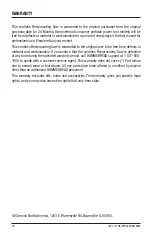
20V 7/8" RECIPROCATING SAW 15
OPERATING INSTRUCTIONS
a. Mark the line to be cut clearly on the work.
b. Set the tool with one edge of the footplate firmly against the material.
c. Place the tip of the blade (not running) on the line to be cut.
d. Tilt the saw so that the blade clears the work.
e. Depress the lock-off button and hold it in place, Squeeze the variable-speed trigger
switch and carefully engage the moving saw blade into the material.
f. After the blade penetrates through the work, continue sawing along the marked
outline.
WARNING:
Do not plunge cut into metal surfaces. In thick materials and in harder
materials, such as metal, plunge cutting should not be attempted. Such materials can be
cut with the reciprocating saw only by starting the cut from the edge of the material or from
a hole drilled all the way through the material that is large enough to fit the saw blade.
8. Metal Cutting
WARNING:
Never use the wood-cutting blade for cutting metals. Failure to do so
could result in serious personal injury.
The saw can be used to cut metals, such as sheet steel, pipe, steel rods, aluminum, brass,
and copper. Be careful not to twist or bend the saw blade. Do not force the tool.
The use of cutting oil is recommended when cutting soft metals and steel. Cutting oil will
keep the blade cool, increase the cutting action, and prolong blade life.
WARNING:
To avoid possible serious injury:
• Never use gasoline as cutting lubricant, because normal sparking could ignite the
fumes.
• Securely clamp the workpiece in position, and make the cut close to the clamping
point to minimize vibration.
• When cutting conduit pipe or angle iron, clamp the work in a vise, if possible, and
cut close to the vise.
• To cut thin sheet material, “sandwich” the material between pieces of hardboard
or plywood, and clamp the layers together to reduce vibration and tearing of the
material.




















